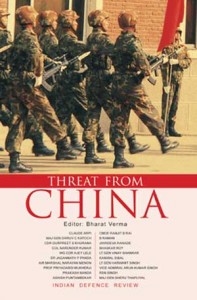The Indian Defense and security establishment has been aware of the project ever since its inception. “¦ it has taken no counter measures to neutralize the strategic advantage that China would derive.
—-. The Chinese Government has tried to delude us by professions of peaceful intention. My own feeling is that at a crucial period they managed to instill into our Ambassador a false sense of confidence in their so-called desire to settle the Tibetan problem by peaceful means. There can be no doubt that during the period covered by this correspondence the Chinese must have been concentrating for an onslaught on Tibet. The final action of the Chinese, in my judgment, is little short of perfidy. The tragedy of it is that the Tibetans put faith in us; they chose to be guided by us; and we have been unable to get them out of the meshes of Chinese diplomacy or Chinese malevolence.
Our Ambassador has been at great pains to find an explanation or justification for Chinese policy and actions. As the External Affairs Ministry remarked in one of their telegrams, there was a lack of firmness and unnecessary apology in one or two representations that he made to the Chinese Government on our behalf. — Therefore, if the Chinese put faith in this, they must have distrusted us so completely as to have taken us as tools or stooges of Anglo-American diplomacy or strategy.
This feeling, if genuinely entertained by the Chinese in spite of your direct approaches to them, indicates that even though we regard ourselves as the friends of China, the Chinese do not regard us as their friends. — During the last several months, outside the Russian camp, we have practically been alone in championing the cause of Chinese entry into UN and in securing from the Americans assurances on the question of Formosa. We have done everything we could to assuage Chinese feelings, to allay its apprehensions and to defend its legitimate claims in our discussions and correspondence with America and Britain and in the UN.
Inspite of this, China is not convinced about our disinterestedness; it continues to regard us with suspicion and the whole psychology is one, at least outwardly, of scepticism perhaps mixed with a little hostility.—- Their last telegram to us is an act of gross discourtesy not only in the summary way it disposes of our protest against the entry of Chinese forces into Tibet but also in the wild insinuation that our attitude is determined by foreign influences. It looks as though it is not a friend speaking in that language but a potential enemy.
Also read: China’s Threat Perception
In the background of this, we have to consider what new situation now faces us as a result of the disappearance of Tibet, as we knew it, and the expansion of China almost up to our gates. Throughout history we have seldom been worried about our north-east frontier. The Himalayas have been regarded as an impenetrable barrier against any threat from the north. We had a friendly Tibet which gave us no trouble. — China — is united and strong.
 All along the Himalayas in the north and north-east, we have on our side of the frontier a population ethnologically and culturally not different from Tibetans and Mongoloids. The undefined state of the frontier and the existence on our side of a population with its affinities to the Tibetans or Chinese have all the elements of the potential trouble between China and ourselves. — Chinese ambitions in this respect not only cover the Himalayan slopes on our side but also include the important part of Assam.They have their ambitions in Burma also.—–. While our western and north-western threat to security is still as prominent as before, a new threat has developed from the north and north-east. Thus, for the first time, after centuries, India’s defence has to concentrate itself on two fronts simultaneously. Our defence measures have so far been based on the calculations of superiority over Pakistan. In our calculations we shall now have to reckon with communist China in the north and in the north-east, a communist China which has definite ambitions and aims and which does not, in any way, seem friendly disposed towards us.
All along the Himalayas in the north and north-east, we have on our side of the frontier a population ethnologically and culturally not different from Tibetans and Mongoloids. The undefined state of the frontier and the existence on our side of a population with its affinities to the Tibetans or Chinese have all the elements of the potential trouble between China and ourselves. — Chinese ambitions in this respect not only cover the Himalayan slopes on our side but also include the important part of Assam.They have their ambitions in Burma also.—–. While our western and north-western threat to security is still as prominent as before, a new threat has developed from the north and north-east. Thus, for the first time, after centuries, India’s defence has to concentrate itself on two fronts simultaneously. Our defence measures have so far been based on the calculations of superiority over Pakistan. In our calculations we shall now have to reckon with communist China in the north and in the north-east, a communist China which has definite ambitions and aims and which does not, in any way, seem friendly disposed towards us.
Let us also consider the political conditions on this potentially troublesome frontier. Our northern and north-eastern approaches consist of Nepal, Bhutan, Sikkim, Darjeeling and the tribal areas in Assam. From the point of view of communication, there are weak spots. Continuous defensive lines do not exist. There is almost an unlimited scope for infiltration. —-. The contact of these areas with us is by no means close and intimate. The people inhabiting these portions have no established loyalty or devotion to India.
 —- Nepal has a weak oligarchic regime based almost entirely on force: it is in conflict with a turbulent element of the population as well as with enlightened ideas of the modern age. In these circumstances, to make people alive to the new danger or to make them defensively strong is a very difficult task indeed and that difficulty can be got over only by enlightened firmness, strength and a clear line of policy.—– In my judgment the situation is one which we cannot afford either to be complacent or to be vacillating. We must have a clear idea of what we wish to achieve and also of the methods by which we should achieve it. Any faltering or lack of decisiveness in formulating our objectives or in pursuing our policies to attain those objectives is bound to weaken us and increase the threats which are so evident.
—- Nepal has a weak oligarchic regime based almost entirely on force: it is in conflict with a turbulent element of the population as well as with enlightened ideas of the modern age. In these circumstances, to make people alive to the new danger or to make them defensively strong is a very difficult task indeed and that difficulty can be got over only by enlightened firmness, strength and a clear line of policy.—– In my judgment the situation is one which we cannot afford either to be complacent or to be vacillating. We must have a clear idea of what we wish to achieve and also of the methods by which we should achieve it. Any faltering or lack of decisiveness in formulating our objectives or in pursuing our policies to attain those objectives is bound to weaken us and increase the threats which are so evident.



